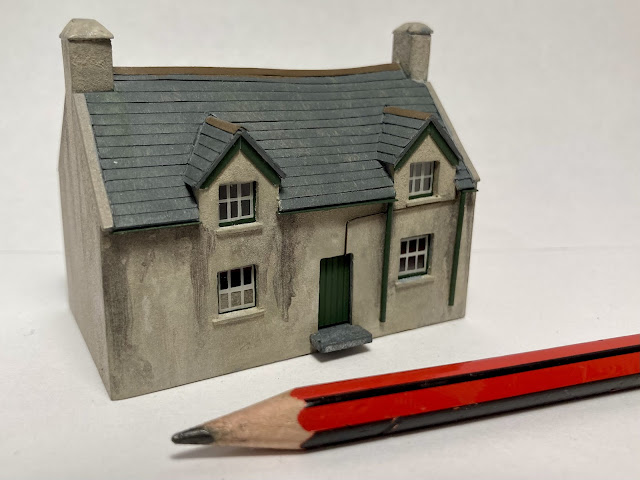Bae Ceredigion: Nant Geseiliog farm again (N part 40)...
What is model making if not an art in itself? Must our model railways only portray the railway itself with heart and feeling? Can we find inspiration in structures and scenes beyond the boundary?
Until my journey into N and the mental challenges that it has brought and resolved around scalability of my craft, of technique and even my ability I would have focused on the locomotives and stock with the scenery more of secondary value. Yes, I appreciate a good layout scene, I endeavour to craft realistic surroundings for my models, to compose scenes that feel right both in their physical and social geography senses (the landforms and the structures) but they were 'secondary' to the lead actors who strut their stuff across the stage. In recent weeks thoughts of 'what next' for N have moved from a small cameo follow up to a more extensive 'exhibition' layout, and with that a dive into the Cambrian in the 1970s and 80s. The research has involved my usual trawling of Flickr but also the acquisition of a few new books for the library and it was in the pages of one of these that I first stumbled upon the subject of this model, Nant Geseiliog farm, north of Tonfanau (and Tywyn) on the Cambrian coast.
The structure had been photographed by the railway historian C.C. Green for his second Wild Swan volume and the black and white photograph with Mini Countryman parked out the front had such presence on the page that the structure itself felt to me like it should take the stage, for the role of lead actor to perhaps move beyond the ribbons of steel and to embrace the mundane yet characterful structure.
Why did I feel this way? It reminds me of Welsh farm houses I spent happy summer holidays at in Pembrokeshire in the late 1980s and early 1990s. That mix of old pebble dash render and stonework, tired but still standing, real buildings not like the brick built suburban houses back home. Perhaps modelling this structure could tap into those memories, that melancholic nostalgia?
For some years I've had a nagging ambition to build something isnpirect by the old Wild Swan 'Cottage Modelling for Pendon' book, I've even experimented with card and other materials but this has been the first model that I'm genuinely proud of and believe stands alone without the need for a railway.
 |
| Note, the model will be buried about 2-3mm into the layout, ground rising from right to left. The door step will be on the ground level. |
Of course, whilst it stands alone - it won't for long as I hope to use this along with some other items I would like to build for the new layout - but that story begins another day. For now, I will continue to enjoy casting an eye of what I have created and the promise of what it holds. Until next time, more soon...
Donate
I love writing and creating material for the blog. If you enjoy what you read and engage with I would be appreciative of any donation, large or small, to help me keep it advert and restriction free.



Congratulations on a very fine structure model. And thank you for using a pencil as a "size helper." Models of locos or rolling stock are often posed next to a coin (such as Phil Parker's recent blog post of Polar Bear on a 50p coin,) which works if you're familiar with the coin. As an American, I don't have a grasp of the size of a 50p coin. I do know the size of a pencil--much more helpful.
ReplyDeleteThank you Jeffrey, and that is why I chose the pencil, as I’m familiar with my ‘world wide’ audience that coins aren’t always a great measure of size!
DeleteThis is an excellent point, Jeffrey. The same assumption has confused me when reversed. I'm aware of the existence of a dime but I'm never sure how much it's worth, much less how big it is. Pencils are universal.
DeleteBeautiful model, James - the extra effort with the slates makes a big difference. Can't wait to see this in situ